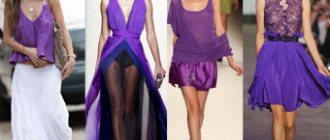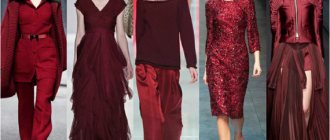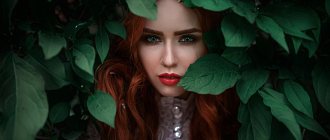Origins of color
In the color system, violet is considered a third-order color, between purple and blue. The etymology of its name has a long history. The Latin word "viola" is believed to have originated first. Later it was borrowed by French and German. In these languages, purple sounds like “violet”. The word "fioletowy" is a Polish version of the name, from which the Russian "violet" comes.
Most people associate this color with violet blossoms. It is classified as cool shades. Purple is the color of luxury, mysticism and nervous instability.
Until the 19th century, when synthetic dyes were invented, obtaining this shade was incredibly difficult. Artists of the Byzantine Empire made purple paint from the ink secretion of mollusks. A small jar of dye required about 250 thousand soft-bodied animals. The paint turned out to be very durable and rich. This shade was rightly called royal.
What does it mean in psychology?
The color violet is obtained by mixing blue and red, so psychologists often consider it an intermediate color , partially combining the features of red and blue.
There are various shades of purple, such as fuchsia, lilac, adelaide and others, differing from each other in the characteristics of the combination of red and blue, brightness and saturation.
Interesting information about the color purple:
- despite the fact that purple is based not only on blue, but also on red, it is considered a cold shade;
- during the Middle Ages, the color purple symbolized grief due to the death of someone from the royal family;
- purple also symbolized the power of kings.
What does purple mean in psychology? Find out from the video:
Symbolism
Johannes Itter wrote that dark purple is the color of disaster. But once it is illuminated, all the mystical horror turns into nobility and peace of mind. This color combines the masculine active and feminine passive principles. It simultaneously conceals depth and challenge, unity and conflict. Purple is a mixture of magical blue and hot red. This is the unity of two irreconcilable elements. Such a union can give either everything or nothing.
Purple is the harmony of opposites that have been reconciled. The cool blue tone calms the vibrant energy of red. Bright impulses of red awaken to life and dilute the dreary depth of blue. Thus, the components of violet color provide it with balance and poise.
Since ancient times, this color has been considered a symbol of everything mystical and inexplicable. In books you can often see magicians and wizards dressed in purple outfits. In religions, the symbolism of this shade belongs to the spiritual sphere. In the mythology of many countries, the color purple is represented by the wise owl. It is a source of secret knowledge, and in some cultures it symbolizes an ascetic lifestyle and repentance.
The color purple is also associated with spiritual rebirth, personality transformation, and the transition from one state to another. Moreover, such spiritual changes occur abruptly and free the soul from everything old and obsolete.
Purple is the color of creativity, but not ordinary, but beyond the limits of consciousness. Esotericists consider it not a human color, but rather an otherworldly one
In Buddhism, purple is the color of the seventh chakra, which is responsible for the highest level of spiritual consciousness. This energy center is located at the crown and symbolizes pure intuition, celestial knowledge and connection with the cosmos.
The ancient Egyptians associated this color with a particle of the soul that remained alive after death. This spiritual element was called the word “Ba” and was depicted in the form of a bird that served Osiris, the god of death.
In Christian mythology, the color violet is a symbol of sacrifice. In ancient Rome, women wore wreaths of violets as a sign of spiritual and physical purity, humility and abstinence.
Features of use in therapy
The color violet and its meaning in human psychology are used in practice. In particular, it helps hypnologists bring the patient out of hypnosis. Shades of this color can reduce anxiety, get rid of depression and stress.
Knowing what the color purple means in psychology makes it possible to use it correctly in color therapy. This tone increases self-esteem and helps get rid of complexes. You can use it in the design of your workplace: it helps you concentrate.
So, having considered what the color purple means in psychology, we can conclude that it is a very complex tone that affects a person in an ambiguous way. It helps you relax, relieves stress, and increases self-confidence. However, those who involuntarily give preference to it are distinguished by vulnerability, daydreaming, and are predisposed to depression.
IMPORTANT! Informational article! Before use, you should consult a specialist.
Significance in psychology
The influence of the color purple on the human psyche is ambiguous. Its “waters” cannot quench your thirst, but you can easily choke. This color is actively used in hypnosis and meditation. If you follow the technique of spiritual practices, purple helps speed up recovery, activate the self-healing program, normalize brain function, improve memory and concentration. It also develops imagination and has an analgesic effect.
In reasonable quantities, violet color can normalize blood pressure, relieve panic attacks, calm the nervous system, and improve the functioning of the cardiovascular system. But this is not a safe medicine. The dose must be clear and correctly selected.
For men
A man’s attraction to the color purple indicates wisdom and experience, as well as a special perception of the world. He is able to see and feel what others cannot. Perhaps he has psychic abilities that he himself is not aware of.
Representatives of the stronger sex who love purple are distinguished by such qualities as:
extraordinary worldview interest in everything mysterious and unexplored desire for deep self-knowledge isolation, taciturnity external coldness strong empathy desire to be useful to other people desire to comprehend higher spiritual matters
This is a classic description of a man who prefers the color purple. But there are exceptions to this rule. Sometimes a passion for purple speaks of a demonstrative nature, a desire to attract the attention of women.
For women
For the fair sex, the purple hue has a completely different meaning. His lovers usually have a strong inner core, but outwardly they may not show any strength of character. They are used to living by the rules that they came up with themselves. These women are individualists who do not tolerate moral pressure.
Psychologists characterize lovers of this color as follows:
value inner freedom love unusual creativity communicate only with those who share their views in relationships “are not exchanged for small coins” have an emotional nature are very vulnerable and sensitive have a keen sense of the souls of other people
Most of those girls who are crazy about the color purple do not know how to dissemble or pretend at all. They don’t know how to hide their emotions, and they don’t see anything wrong with their sincerity.
Purple is considered a feminine color because it carries the energy of emotions and the subconscious.
For children and teenagers
Kids who like purple have a bright and rich imagination. Perhaps these are future artists, writers or designers. Often such children have artistic behavior and try to express themselves as individuals.
It is worth noting that the influence of purple on children, as well as on adults, is quite controversial. This color simultaneously denotes the depth of the soul and demonstrative pride, mysticism and sacrifice, abstinence and craving for vices. Therefore, children who love this color may be tormented by an internal struggle.
Children who are fond of purple things usually have the following psycho-portraits:
they are easily suggestible, but can easily influence others; constant contradictions in feelings and desires bring them discomfort; they are in dire need of encouragement and support; they can often express their feelings and interests in the form of an exciting game; they have strong intuition.
Negative effects of color
Violet is a very energetically strong color, so it is easy to overload the psyche. Psychologists consider it somewhat difficult, so you need to approach violet color therapy with extreme caution.
Purple is known to suppress appetite. It can be useful for overweight people, but thin people should not get carried away with it. Violet in excess reduces the ability to think rationally, causes overexcitation and irritation.
Purple is the color of the chosen ones; one cannot remain indifferent to it. Almost all people react strongly to this color. Some people adore it, others hate it, but it’s difficult to be neutral about this color. A rich, dark shade of purple can have a very bad effect on an unstable psyche. But light lilac shades act more softly.
Experts do not recommend getting carried away by purple people with a phlegmatic temperament. It is also better for melancholic people to avoid it. Constantly surrounding oneself with violet, a person becomes withdrawn and silent, gets carried away by mystical practices and withdraws from reality.
Shades of purple
The color purple has many unusual shades. There are 196 of them in the Panton palette. Here are the main ones:
Amethyst
It has a pink undertone, so it is characterized as warmer and more pleasant. Denotes fantasy, tenderness, dreaminess.
Eggplant
Has an admixture of black. Deep and rich, but can be light and dark. A darker eggplant emphasizes depth, while a lighter one can look flashy and vulgar.
Indigo
A mixture of dark blue and dark purple. A mystical and calm color that is associated with wisdom and balance.
Lavender
This is a light shade of lilac with a hint of gray. It looks very gentle and fresh, evokes positive emotions.
Purple
Elegant and ceremonial color. Combines blue and pink shades. Gives a feeling of celebration and well-being.
Combination with other colors
If we are talking about light shades of purple, then they look better in low-contrast compositions. Darker and deeper shades take advantage of combinations with other rich colors. Bright purple color suppresses all other colors, so the best option would be a combination of its moderate shade and other muted tones.
Purple and pink
A mysterious and juicy combination, it is not intrusive. A cool shade of moderate pink seems to be a continuation of the purple tone. The richer the pink color, the more the depth of the purple is emphasized, and the lighter it is, the clearer its contours become against the background of the main color.
Purple and red
Red color is one of the integral components of purple, so this combination is both contrasting and complementary. This is a sensual and exciting color union, enveloping the consciousness with unusual and mysterious images.
Purple and burgundy
This is a calmer, but no less deep and effective combination. Noble crimson shades softly set off the main color. Cherry, wine and ruby tones also look good in combination with a moderately saturated purple color.
Purple and orange
This combination cannot be called harmonious, because the proximity of these colors looks defiant and catchy. The strong contrast of warm and cold tones creates tension. But if in general these colors create a contradictory impression, then in the case of individual combinations you can get a very interesting and successful combination. For example, eggplant color harmonizes perfectly with coral and peach shades.
Lovers of purple
Psychologists characterize lovers of this unusual color as extraordinary, creative and freedom-loving people. Their life is full of surprises and surprises. Their life path resembles an attraction. They only dream of peace.
Most purple lovers are sociable individuals. Sometimes they need pauses in activity, during which they seem to hibernate. But this is the “calm before the storm”, a rest before new achievements.
A person who likes the color purple is quite sociable, but he is only interested in conversations on philosophical and mystical topics. He may seem like an eccentric to those around him, so, as a rule, such individuals are looking for their own circle of friends.
Only “select” people, endowed with amazing intuition and the ability to understand inexplicable things, can experience a strong craving for purple shades
These people are “not of this world”; they are very smart by nature. They don't have to spend hours reading books to gain valuable knowledge. It’s as if the cosmos itself sends them heavenly wisdom, and they only pass it on to other people.
Often, purple lovers are interested in magic, esotericism, and paranormal phenomena. They are fearless and strong in spirit, but are often deprived of health. This is a kind of payment for high intelligence and superpowers.
Who likes the color purple?
Those who like the color purple have an unusual perception of reality. More often these are dreamers who prefer spiritual values to material ones. These can be creative people, for example, artists, musicians, writers.
Lovers of this color scheme have the following qualities:
- intuition;
- determination;
- empathy;
- vulnerability;
- independence.
These people are also distinguished by the desire to be different from everyone else. Sometimes it's extravagance.
Use in clothing
Violet shades in the wardrobe are preferred by extraordinary and courageous people, most often women. Things of this color are worn by girls who strive to be original. Purple is truly capable of creating a unique and memorable image, but only a person with good taste can combine it correctly with other colors.
It's easy to overdo it with purple, so it's better to have one or two things of this shade. This could be a light lilac blouse or a summer dress. If we are talking about evening wear, then dresses in rich purple shades will look luxurious and advantageous. But it is worth noting that such an outfit requires an almost perfect image. Hairstyle, makeup, shoes - everything should be on point.
Bright shades of purple suit hot brunettes, but girls with blond hair need to be careful with them. For blondes, clothes in a pale lilac shade are suitable. If we are talking about a purple headdress or scarf, then in this case it is also worth paying attention to gentle and restrained tones.
Lilac color in clothes
Many women love lilac. However, as practice shows, it is not suitable for everyone. What can be said about those who choose clothes of this shade?
- These are self-sufficient people who love rigor and restraint.
- Sometimes they are overly self-confident and have no complexes. To a small extent, lilac is considered a defiant, flashy color. Therefore, he attracts the attention of others.
- This spectrum gives the image mystery and mystery. It adds a touch of romance.
- Previously, the color lilac was a sign of position in society and status. Now, according to many, it also indicates well-being.
Interestingly, this tone does not hide figure flaws, like black, for example. Therefore, people who wear such clothes are distinguished by their courage and independence from the opinions of others. They are not afraid to show their flaws.
Purple color in the interior
Purple color can be used in the interior of an apartment or office, but you should use light and delicate shades so as not to create an oppressive and heavy atmosphere. Purple in the interior goes well with white and gray. You can add a brighter color - light green, purple or orange.
Purple accents in the room help develop creative imagination and focus on studies. They calm hyperactive individuals and stimulate passive ones. This color will be appropriate in the offices of creative people who need constant inspiration.
Muted hues of wine, eggplant and plum in the kitchen distract attention from clutter, they are practical and stylish. In addition, purple tones help you lose weight because they suppress excess appetite.
In the living room, purple shades are very appropriate, provided that the room is well lit. They provide an atmosphere of solemnity and look majestic, especially in combination with accessories made of gold, silver and crystal.
As for the bedroom, here you can put furniture with purple elements in colors. The walls can be light lilac, plain or with a small pattern. In the bedroom there should be purple shades in moderation, especially if it is a children's room. It is best to use two or three small interior items, for example, a painting, a rug by the bed, or an ottoman.
In the interior, purple is best combined with white, black, gray, burgundy and lilac. In general, it is advisable that there be no more than two or three flowers.
Purple color will add spice to the bathroom. It will lift your spirits in the morning and relieve stress in the evening. You can use tiles with a purple pattern and frame the mirror area with purple. Thus, purple will distract attention from tired and ugly images.
Meaning in clothing, interior
Considering who loves the color purple in psychology, researchers note that these are perfectionists who do not like half measures. They do everything conscientiously, are distinguished by confidence in their own rightness, and are often passionate about understanding the mysteries of life. Those who prefer clothes of this tone prefer privacy, do not like noisy companies, and are prone to melancholy. Excessively attached to their loved ones, they painfully experience separation from them.
Being in constant search for themselves, they often change hobbies. Having lost interest in one type of occupation, they devote themselves wholeheartedly to another, but if the task loses value for them, they will not finish what they started. They are characterized by developed empathy - such people subtly sense the mood of their interlocutor and are able to adapt to it. Their lives are often controlled not by the mind, but by the heart, so they, driven by compassion, often commit intuitive, illogical actions. Such people can hardly be called uncommunicative, but they value personal space and love private one-on-one conversations; they feel uncomfortable in large companies. People who wear purple are creative, extraordinary, but very sensitive and vulnerable.
Wear purple clothes made of velvet or silk; these materials best form a harmonious pair with an unusual complex shade.
This tone is also used in interior design: bedrooms, corridors, bathrooms. It is well suited for creative areas, as it helps to tune in to the wave of creativity and catch inspiration. This is the color purple: the meaning in psychology can be safely applied when thinking through an interesting design for your home. However, experts do not recommend choosing it in its pure form. It is better to combine this rich shade with white, gold, yellow, and warm orange. Being in a room decorated in purple tones will protect you from stress, restore mental well-being, help normalize sleep and relieve depression.
Knowledge of what the color purple means in human psychology is used by competent PR specialists and advertising services. In combination with soft pink, it has a powerful effect on young girls, forcing them to buy products from perfume and cosmetic brands. In addition, the shade has its effect in promoting goods for creative activities, inevitably attracting the close attention of creative people. It is used infrequently in advertising of other products because it promotes relaxation. The buyer calms down and gradually loses interest in the product. The shade's relaxing effect is especially noticeable when combined with herbal green.
Use in advertising
The color purple is not often used for advertising purposes. On the one hand, it brings concentration and harmony, and on the other, disunity and internal struggle. It also stimulates creativity, makes you delve deeper into yourself, and realize your true desires.
Marketers use this color to promote products that have just entered the market. These can be new products made with a creative approach, as well as various products for creativity. Most often, several purple elements are used in advertisements to unobtrusively place the right accents.
Purple evokes mixed feelings because it combines the feminine and masculine. Experienced advertisers use it to influence people who want to challenge society, change radically, and start life from scratch. The greatest effect is achieved with a combination of purple and bright yellow.
Purple helps you escape from reality, relax, and immerse yourself in the world of dreams and fantasies. Therefore, this color is suitable for decorating sweets, alcoholic beverages, perfume, and toys.
Psychology and the color purple
Purple color in psychology is one of the least studied. It is rarely chosen as a favorite color. Experts say that purple tones can have different effects on a person’s well-being and psyche, depending on the specific situation. For example, from the abundance of purple color a person can:
- Feel sadness and hopelessness;
- Sink into depression;
- Find non-standard, creative solutions to existing problems;
- Go deeper into yourself, fall into a contemplative, thoughtful or lyrical mood.
All shades of purple are known to enhance intuition, which is why clairvoyants love this color.
Health effects
As already mentioned, the effect of this color on health is not clear. It all depends on the individual characteristics of each organism. According to scientists, the area of influence of violet is the pineal gland, located in the diencephalon. This is where all the “mental” signals come from, so purple is heavy and should be used with caution.
An excess of this color can cause depression and depression. The appropriateness of treating children with this color is questionable. But a moderate amount of purple stimulates brain function, normalizes the lymphatic system, improves the functioning of the spleen and parathyroid glands. This color has also been proven to be effective in combating migraines as it acts as a pain reliever. Purple can enhance the effect of anesthetics and narcotics.











